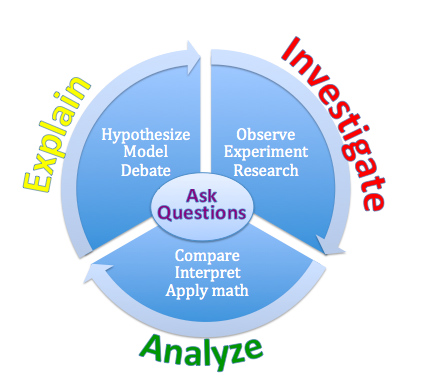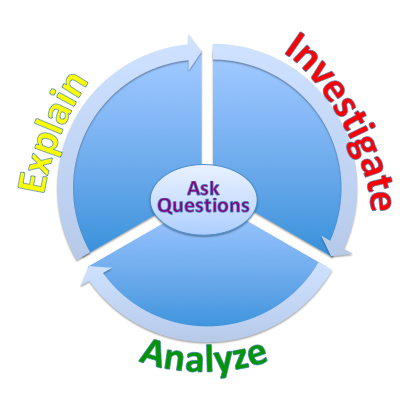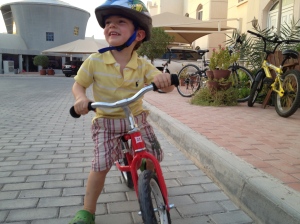Call it whatever you want: scientific inquiry skills, practices of scientists, the scientific method- all science teachers are aware of the value of teaching skills as well as content knowledge. But I would go a step further and say that scientific skills are the most important thing our students can learn. Even if my students remember none of the scientific facts or concepts they learned in school, if as adults they are able to think critically like a scientist, then I think this world will be alright. As Carl Sagan puts it so eloquently in his brilliant manifesto about the importance of scientific literacy: “The method of science, as stodgy and grumpy as it may seem, is far more important than the findings of science.” (pg. 22)
It used to be a simple matter teaching scientific skills, back when they were all packaged up neatly in the “Scientific Method”. I’m sure almost all of us had those steps hammered into our skulls lab after lab after lab: question, hypothesis, procedure… zzzzzz. Of course it was mind-numbingly dull to experience science in that over-simplified, lock-step fashion, not to mention completely wrong. Science doesn’t actually work that way- they don’t follow any standardized linear method. A recent study (Reiff et al., 2002) of how scientists actually do science was revealing: although there were many common skills and practices, there was no clearly defined path or order. So to describe the real scientific method the researchers created this “inquiry wheel”:
When I read about the inquiry wheel in grad school, I was more surprised with the similarities it shared with the old-school scientific method than the differences. It seemed like a mere repackaging of the same old method,with just a breaking down of its stale step-by-step order. I wondered if by making the scientific method a thing of the past, we teachers would throw the baby out with the bathwater in our eagerness to purge it from our pedagogy. If we aren’t going to teach the scientific method to students, then how will we present the many practices that scientists use and students should surely learn? While this wheel might paint a more accurate picture, it didn’t appeal to me as an educator for use with my students.
For all of its flaws, I believe the scientific method successfully models one approach to doing science for students. So what I’d like to do is give that model a makeover- and create something that simply structures the process of doing science while also allowing for the flexibility that reflects real practice. Behold, the Scientific Cycle!

To create the Scientific Cycle I’ve taken the familiar scientific skills of the Scientific Method, synthesized them with an updated version of “science and engineering practices” from the framework for new education standards in the US, and framed them in a simple cyclical process, inspired by the inquiry wheel. Like the wheel I’ve put Asking Questions at the center of the whole thing, because questioning is at heart of science and can be done at any stage in the process. However, unlike the wheel, I favored a cycle as opposed to keeping it totally non-linear, because I believe the general process of Investigate-Analyze-Explain is a beneficial simplification for students. What you lose in realism you gain in students being able to learn and internalize the process.
By far my favorite aspect of the Cycle is the flexibly of the specific skills involved. In the classroom I plan on starting with the Cycle blank, like this: 
Then as we investigate a concept, we can highlight the skill we’re focusing on by adding it to the cycle. This skills might be different depending on the type of investigation: in one case we might investigate a question by planning and conducting a controlled experiment, analyzing and interpreting the data with the use of a graph, and then explaining the results by writing a conclusion. In another we might investigate by conducting some research, analyze by comparing the information found from various sources, and then explain by debating the answer to our question. So whether you’re researching, observing, experimenting, or just exploring, the Cycle still works and provides a good framework for scientific skills, while also teaching students that scientists approach questions in different ways.
Whaddaya think? What would you change/add/remove? Does this fit at different levels and in different subjects? The Cycle has been percolating in my mind for quite some time, so it would be great to get some feedback from other teachers.
Read Full Post »
 One of the highlights of my summer was watching my son Graham learn how to ride a bike. He’s only 3 years old- so I was blown away when he took off without training wheels on the 3rd day of riding. I’m pretty sure I didn’t ride a two-wheeler until I was like ten, and that was after many, many knee-skinning spills! How did Graham do it? His secret is using a balance bike and avoiding the pitfalls of “training wheel teaching”, which is a metaphor that I think will serve me well in my own classroom.
One of the highlights of my summer was watching my son Graham learn how to ride a bike. He’s only 3 years old- so I was blown away when he took off without training wheels on the 3rd day of riding. I’m pretty sure I didn’t ride a two-wheeler until I was like ten, and that was after many, many knee-skinning spills! How did Graham do it? His secret is using a balance bike and avoiding the pitfalls of “training wheel teaching”, which is a metaphor that I think will serve me well in my own classroom.



